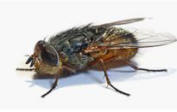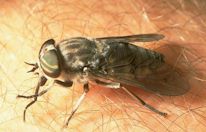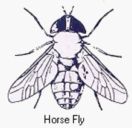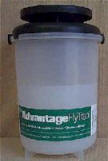
- Adult flies are brownish, hairy, robust and about 2/3-inch long,
superficially resembling honey bees except for having only
 one pair of
wings. Wings of the horse bot fly have faint smoky spots on the wings.
Fully-grown larvae (maggots) are ½ to 2/3 inch long and have
yellow-white to pinkish thick, tough skin. They are blunt at one (the
back) end, and taper to the other (front) end which bears a pair of
strong, hook-like mouthparts. Each body segment is ringed with strong
spines.
one pair of
wings. Wings of the horse bot fly have faint smoky spots on the wings.
Fully-grown larvae (maggots) are ½ to 2/3 inch long and have
yellow-white to pinkish thick, tough skin. They are blunt at one (the
back) end, and taper to the other (front) end which bears a pair of
strong, hook-like mouthparts. Each body segment is ringed with strong
spines. - Several other species of bot flies occur on horses (chin fly or throat bot fly, Gasterophilus nasalis (Linnaeus); and, lip or nose bot fly, G. haemorrhoidalis (Linnaeus)). They can be identified, in part, by the shape of the eggs.
- Horse flies feed by sucking blood and cause a painful and severe bite. These flying pests are closely related to Deer flies. Often confused with Deer flies, Horse flies are a little larger in size. The wings of this fly have dark markings and their body is brown or black in color.
- The female of the species feeds on animal blood, while her male counterpart is a pollen collector. Horse flies deposit their eggs in damp areas around bays, lakes, ponds or swamps. The larvae of this fly feeds on insects and can be found developing in wet areas.
- he female of the species feeds on animal blood, while her male counterpart is a pollen collector. Horse flies deposit their eggs in damp areas around bays, lakes, ponds or swamps. The larvae of this fly feeds on insects and can be found developing in wet areas.
- Most horse flies and deer flies are found in brushy or
low lying pasture areas near creeks, streams or tanks that provide
 damp
soils in which the immature stages develop.
damp
soils in which the immature stages develop. - Maggots have mouth hooks that tease tissue apart in the digestive tracts; adults do not have functional mouthparts. Horses, mules, donkeys are primary hosts. Adult female flies, attempting to lay eggs on host animals, cause horses to flee and resist fly "attacks" (hovering, buzzing and striking), occasionally resulting in injury. Larvae live in the digestive tract, injuring the tongue, lips, stomach lining and intestine. They apparently feed on the inflammatory products produced by the host in response to their presence. Infestations cause mechanical injuries and an infected ulcerous condition that progressively starves the host animal
- Larvae develop in the digestive tracts of host animals during the winter. In the late winter and early spring months, full grown larvae are found in host’s feces. From there, they burrow into the soil and form a puparium from their last stage (instar) larval skin. They transform into adult flies inside the puparium and emerge in 3 to 10 weeks.
- Adults are active from mid-summer through fall. Adult females glue eggs on the hairs of horses, particularly to hair on the front legs but also on the belly, shoulders and hind legs. Eggs hatch in 10 to 140 days with the proper stimulus (moisture, heat and friction) caused by the horse licking or biting egg-infested hair. Tiny first stage (instar) larvae enter the mouth and burrow into the tongue for about 28 days before they molt and travel to the stomach where they remain for 9 to 10 months, developing into the third stage after about 5 weeks. There is one generation per year.
- They are important vectors of diseases such as leucocytozoan disease of turkeys
- Horse fly and deer fly adults are vicious biters. They cause livestock to lose weight and may transmit anaplasmosis, anthrax and other diseases.
-
The nature of this fly makes it impossible to eliminate through spraying programs. The only trap which has given any
 success with biting
flies (such as the Horse fly and Stable fly) is the Advantage Fly Trap;
the success has been limited. The new technology of this product enables
us (for the first time) to actually attract and capture blood-sucking
flies, in some instances. Results vary with each species and location,
but this trap can capture many kinds of flies.
success with biting
flies (such as the Horse fly and Stable fly) is the Advantage Fly Trap;
the success has been limited. The new technology of this product enables
us (for the first time) to actually attract and capture blood-sucking
flies, in some instances. Results vary with each species and location,
but this trap can capture many kinds of flies. -
If Horse Flies are found inside a structure, make sure that all possible entry points have been eliminated. They will not be found breeding indoors as a house fly will. Ultimate fly control is to eliminate all possible breeding grounds and feeding sources. This type of fly control is almost impossible with the horse fly, as can be seen in its biology.